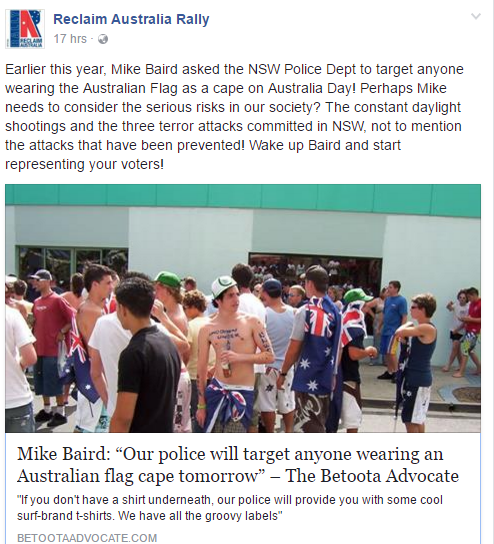The Facts On “Fake News” (And Why It’s Not A Catch-All For Everything You Don’t Like)
This mess has changed the entire way we talk to each other about the news.

There’s been a lot of talk about ‘fake news’ since Donald Trump was elected but, as time goes on, the meaning of the term has become as confusing and redundant as a Bill Shorten Budget Reply.
“Fake news won him the election!” people scream. “Fake news was promulgated by the great stupid unwashed masses who just so happen to support my political opponents!” “Fake news is to blame for why I can’t stay in a stable relationship!” “Lies, everywhere we look!”
FAKE NEWS – A TOTAL POLITICAL WITCH HUNT!
— Donald J. Trump (@realDonaldTrump) January 11, 2017
What was originally a term for patently untrue nonsense delivered deceptively (and completely without irony) has now been co-opted to describe pretty much whatever people don’t like, whether it’s satire, propaganda, biased reporting, or unbiased reporting of irrefutable facts that the describer would really rather have ignored.
How have we got to this point (and how the hell do we get out)?
The Rise And Rise Of Fake News
The OG Fake News are screeds, gussied up to look like legitimate reports, that are knowingly wrong. It’s the nonsense published on partisan blogs and clip-art littered websites with a lot of imagination or misinformation. It’s astounding how many blogs like dontforgethismiddlenameishussein.com have access to “anonymous sources” in the FBI and CIA…
These sites are the ones that produce stories that culminate in things like Pizzagate (that ‘news’ about Hillary Clinton running a celebrity occult pedophile ring). They are a mix of conspiracy theory message board, troll chatroom, and faux-journalistic integrity, with that last point being the most important.
Fake news stories (and fake news sites) are conveyed in such a way so as to trick you into thinking they’re presenting verified and well-documented news. They have “sources” and “off-the-record informants” and links to other sites. Fake news sites try to look legitimate by presenting information with hyperlinks, as if to say “see, someone else is also reporting this!” But nine times out of ten, these links just go to other fake news sites, which link to other fake news sites, which sometimes link back to the original. It’s Ouroboros with a neck beard.

“Hillary wears pantsuits to hide her reptile skin.”
A partisan fake news stories get more and more popular, so too do fake news farms — dodgy businesses, usually springing up in developing nations where a US penny is actually worth something, devoted to trawling trending keywords, generating false stories that appeal to people’s interests, and duping people silly enough to only read the headlines. And boy, do they make money.
The more people click through to your website, the more money you make, and what these entrepreneurial rapscallions quickly figured out was that people really want to click the shit out of some US politics links — in particular, pro-Trump, ultra-conservative, inflammatory links. It didn’t matter if the story below the headline wasn’t fact-checked, cross-referenced, remotely believable, or even copied and pasted from other websites; if it was pro-Trump, it’d start raking in those Google AdSense dollars. Seriously, some tried lying positively about Bernie and Clinton to no avail. Just like Russian oligarchs and the old school GOP establishment, Trump was their cash cow.
All this was also heavily favoured on Facebook — where algorithms are designed to pick up on things you view, and feed similar things into your timeline. You click one pro-Trump link, and Facebook registers that you like stories like that. It shows your friends you’re into it on their timelines, and some of them like it, and Facebook registers that as well. Seeing now that you’re only enjoying certain friends and certain stories, Facebook filters out the times your Yankee traitor friends like pro-Clinton stories. The less you see those stories and people, the less you have a chance to engage with them.
Your parents in 1996: Don't trust ANYONE on the Internet.
Your parents in 2016: Freedom Eagle dot Facebook says Hillary invented AIDS.
— Daniel Kibblesmith (@kibblesmith) November 19, 2016
Facebook has faced accusations that this helped swing the election in Trump’s favour; that it should take at least partial responsibility for the proliferation of mistruths. Mark Zuckerberg has since announced a venture to work with fact-checkers to flag disputed content and limit its reach. But this could be too little too late; fake news as a concept has completely wormed its way into our existence.
The Effects Of This Mess
When you tally up the number of “engagements” the top 20 fake news stories generated from social media users during the US presidential campaign, they come out at 8.7 million — 1.4 million more than the top 20 news stories published from reputable sites across the same time period. In non-tech bubble terms, this means more people looked at, shared, and ‘liked’ fake news stories than they did “real news”. (And I use quotation marks there because the third most engaged “real news” story of the election was headlined ‘Melania Trump’s Girl-On-Girl Photos From Racy Shoot Revealed’.)
Though there’s no definitive way to know how much fake news actually influenced the US election, there are some unavoidable facts. Pro-Trump fake news stories generated heaps more traffic for these sites than pro-Clinton ones; pro-Trump fake news stories were circulated more than pro-Clinton ones; the most popular reports from mainstream media included softcore porn; Trump was elected. He obviously wasn’t elected solely off the back of fake news, but it’s hard to believe it didn’t at least partially influence some people to vote for Trump (or convince others not to vote for Clinton).
But beyond Trump’s election and the Pizzagate whoopsie, “fake news” has actually started to change how people talk to each other about the news.
There’s something known as the No True Scotsman fallacy, which is where every time data or evidence is produced refuting your fact, you add yet another caveat to your initial argument, claiming that the evidence produced isn’t describing what you were really talking about. There’s no true scotsman here! But what about that guy from Scotland over there? He’s not in a kilt; only a true Scotsman wears a kilt, so he’s not a true Scotsman, and hence, there are no true Scotsman here! Still! (A good example of this being employed is Senator Malcolm Roberts asking for data about climate change, being shown the data, then claiming that data isn’t real data).
What happens now is that everyone, from political pundits to your crackpot uncle to callback radio hosts, can call anything they don’t like “fake news” in an effort to discredit it. And it is discrediting; despite how many times those sites were “engaged” with, there’s now a big stigma in falling for fake news’ tricks.
What Is And Isn’t Fake News
Here’s the rub. If you’re gonna call something fake news, it better actually be fake news. Language should be important to everyone, from the most venomous progressive at a slam poetry Freegans Anonymous meeting, to the most conservative, immigrant-hating nana. Everyone has a vested interest in communicating properly and not just being heard, but being understood. That means using the right words for the right job.
The dead giveaway about fake news is the intent, and this is a definitional thing. Something is “fake” if it was created for the purpose of bamboozling, not just imitating. To “fake” something is to try, deliberately, to pass it off as legitimate.
So this rules out satire. As funny as it might be when the Reclaim Australia Rally Facebook group shares a Betoota Advocate article, mistakenly thinking it’s real, this isn’t “fake news”.

But some articles out there do promote a partisan agenda, and yet not even all of those count as fake news. Biased reporting, for instance, isn’t fake news. It’s biased. It’s presenting real life things that happened in a tone that, potentially, influences how you process the information. Particularly conservative work from News Corp is a good example of this; even though their bias on political coverage is so thick it’s nearly falling off in stinky, conservative dollops, generally the worst they’ll ever do is deliberately omit something important to the story.
However, a troubling part of this is the fact that sometimes the mainstream, established and reputable press make mistakes. These mistakes usually come about from either repeating someone else’s mistakes without following them up, or too hastily misinterpreting data. And sometimes they can take an awful long time to fix those mistakes (and some people question if that length of time is deliberate in an attempt to garner more of those delectable social media “engagements”).
This has the same outcome as a fake news story going viral (a lot of people believing hogwash), but again, the intent is different. And while there is plenty to be said about a 24-hour news cycle scrambling to compete with instantaneous tweets and blogs, in such a hurry to publish they’ll barely do the minimum required of them to uphold journalistic integrity, this still isn’t fake news. It could be carelessness or human error or a drunk sub-editor, but it’s not fake.
Ultimately what you should be looking out for are fake news sites, not fake news stories. The stories themselves are merely ideas — political memes sparking just enough in our brains to grab our attention. The sites themselves are the difference between someone on Facebook making shit up, and hundreds or thousands of people genuinely being scared that Russia has armed their nukes.
Luckily, there are some ways to spot them:
Check the name
Chances are, if you haven’t heard of the site and can’t find much other trace of the story online, it’s peddling fake news. The Guardian, Al-Jazeera, RT, FOXNews, CNN, MSNBC, SBS; whether you think they’re biased or not, they’re still indisputably real news sites, which will, at worst, only use something substantive to push their agenda or make a mistake (besides The Bolt Report which, legally speaking, no “reasonable person” should take seriously. MyNewsMyCountry.net or EnviropoliticsRUs.co.uk probably aren’t going to be giving you stories worth sharing. Or that are real.
Check the story
Does it sound suspiciously like a conspiracy theory turned true? Has someone finally proven cancer cures are hidden by Big Pharma because the real money is in cancer treatment? Has every major news outlet in the entire world turned this — possibly the biggest story in the world — down leaving it to a plucky young band of bloggers to blow the scoop wide open on their virus-riddled website they registered in March?
Chuck a Google, and see where else is running it. Sometimes, there is a nugget of truth to the stories (like Clinton’s emails), and sometimes it’s total boulderdash like Pizzagate.
Stay sceptical (but don’t be a dick about it)
Ultimately, it’s up to readers to stop the spread of fake news. If you see an inflammatory headline from an oddly-named website: stop, breathe, and spend five seconds researching the veracity of the claims. Then maybe turn off your screen and go for a walk or something. Pat a dog. At least look to see if the major claims are being verified in places that don’t reference each other.
Follow the links (with a virus blocker turned on). Check to see if they’re fake bullshit, satire, biased reporting, a mistake, or a dumb fluff piece. It’s not helping anyone if you yell “fake news!” for anything but the first on that list.
No one likes to be a sucker. Fake news only exists because so many of us have allowed ourselves to consume stuff this way, and that’s on us to fix. It’s time to start demanding more from our news outlets, our journalists, our social media platforms, and our friends.
–
Feature image via Gage Skidmore/Creative Commons.
–
Mitch is a 27-year-old vocalist, comedian, philosopher, part-time radio host, vegan, socialist, utilitarian, reductionist who hates labels. He considers it a life well lead that all his projects somehow involve shouting at strangers. Follow him on Facebook or Twitter.